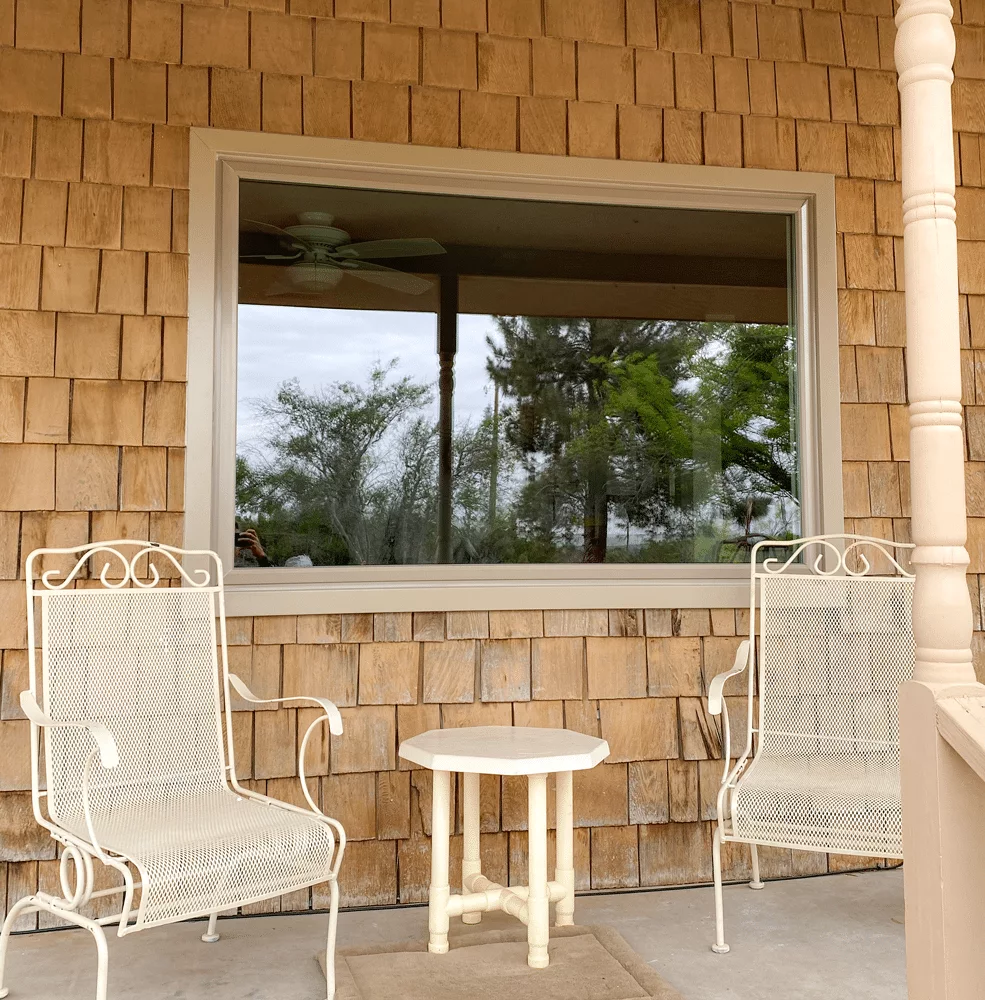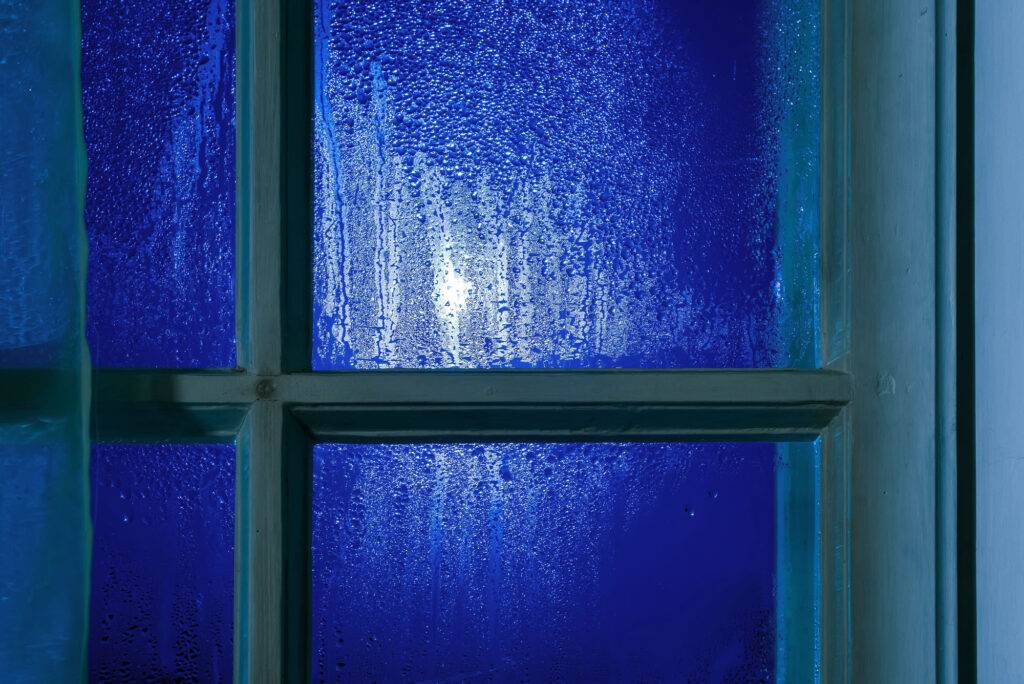
A: Yes it is. What that indicates is that you have a sealed unit failure. What comes with that is you usually can no longer see through the window. So, it’s very foggy, if we get humidity it fills right up where you can’t even see to the outside.
So with that also, it means that your glass is no longer insulating so therefore, it needs to be replaced.
When you see condensation on windows can be a good sign or a bad sign—it all depends on where it accumulates. For example, condensation on the outside of your windows is a strong indicator of good insulation.
The Good Condensation: On The Outside

Normal condensation occurs when the outside air is a bit more humid and warm than the temperature of your window panes. Condensation on the outside of your windows indicates that your windows aren’t allowing any heat transfer. So, that’s good news—that’s what your windows are supposed to do.
Even though it means your windows are just doing a good job insulating your home, we like to be proactive. So, we still recommend checking your window sills and frames to make sure everything is in order.
The Bad: On The Inside Of Your Windows
Now, if you get condensation on the inside pane of your windows you’ll want to look at that closely. Even though interior condensation is normally because of steam from a hot shower or a dishwasher, it can indicate a problem in your home. When this occurs it’s due to higher than average humidity inside your home indicating you might have ventilation issues.
Whenever you have excessive moisture and pooling water throughout your home it can be a threat to your home and your health. If your home is not ventilated properly moisture from your shower, your body, and your water system condenses on your windows. However, it can also end up in your carpet, on furniture, anywhere.
This creates a few serious issues, with the top two being mold and mildew. Mold and mildew usually show up on the walls in your bathroom or under the windows above the kitchen sink. If it’s not dealt with it will accumulate and spread.
This accumulation can wreak havoc on your health as it causes respiratory issues and for asthmatics, it can be deadly.
Also, since your home can’t get rid of the moisture it begins to cause drywall to deteriorate, wood to rot, and so much more. If you let this go unchecked, it can easily end up costing thousands of dollars in repairs.
As bad as that seems, and trust us condensation on the inside of your windows is indeed bad, but read on—it could be much worse.
The Ugly: Within Your Window Panes
If you have issues with the first two mentioned types of condensation you’re ok. However, this third one—is condensation between your window panes. This is an ugly situation and it can seem overwhelming as it means your windows have failed.
This can be costly as the only suitable solution is to replace the windows. Most windows are more than a single-pane. They are often double or even triple-paned. Even though the glass might seem like one sheet of glass, it’s actually a sandwich of glass panes within the frame.
Double and triple-pane windows are built this way to insulate your house. The frame holds the panes securely in position with a spacer and argon gas is sealed in between. When these windows are working properly, that inner chamber is air-tight and creates a barrier from the outside air to insulate your home.
So, under normal circumstances, you should never see any condensation between those panes. It means the seal as broken, the gas has escaped, and your windows are not insulating anymore. As the moisture collects it can turn to mold and mildew as well. But, more importantly you will need new windows—an investment that most people don’t expect.
So, other than condensation between your window panes, the other two can be managed with some feasible measures to reduce condensation.
Reducing Condensation In Your Home
Preventing condensation from forming on the inside of your windows can usually be eliminated with one or more of these steps:
- Use Desiccants: Desiccants are silica beads that by nature, can absorb a lot of moisture. You find them in shoe boxes and many consumer items. Desiccant bags can be purchased on Amazon in bulk if needed. Place the bags anywhere you need to reduce moisture.
- Invest In A Dehumidifier: If condensation tends to be recurring more during the colder months, consider a dehumidifier. You can buy standalone dehumidifiers from most home improvement stores.
- Run Your Fans: Whenever you cook turn on your vent a hood if you have one. When you shower, use a vent fan if equipped. Additionally, leave the bathroom door open when you take a hot shower. If you have ceiling fans, run those to help dry out any excess moisture.
- Circulate The Air: Warm air travels up when in your house. When it’s colder run your ceiling fans clockwise to shift the warm air down to help make the environment more arid.
- Move Plants Outside: Plants inside your house are a usual suspect as a source of added humidity. When it’s colder, relocate your plants away from window sills and do not overwater your plants. It will only add to the excess moisture and can kill your plant.
Don’t Ignore It. Let The Window Source Help!
The worst thing you can do when getting condensation inside your home or especially in between your windows, is to ignore it. All you are doing by not addressing it is prolonging the inevitable and possibly causing bigger issues.
We can install our double-pane, energy-efficient windows in your home that will give you the added insulation you need. Our vinyl replacement windows are made right here in Texas and come with a lifetime warranty.
Schedule your FREE estimate for your home update, and learn more about all of the products and styles we have to offer. Follow us on Facebook and Instagram to see all our before and after photos, as well as what projects we are currently working on. Have a question you need answered now? Chat with a representative by clicking the chatbox on the bottom right corner.
